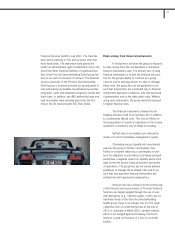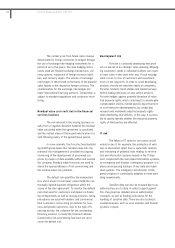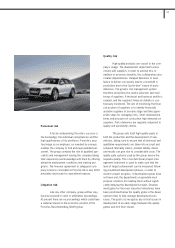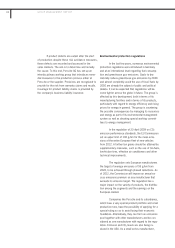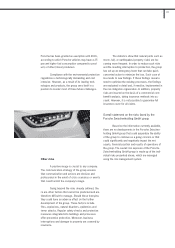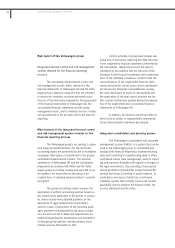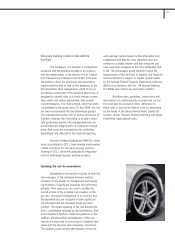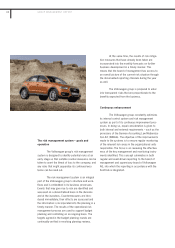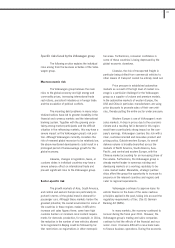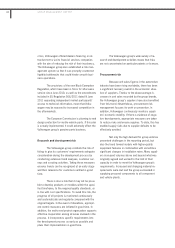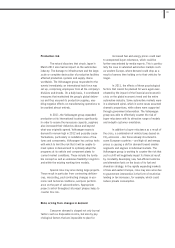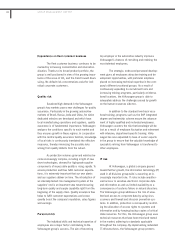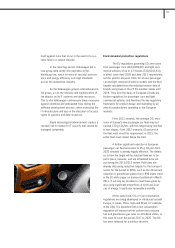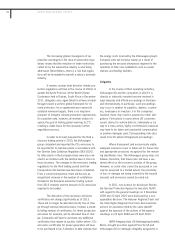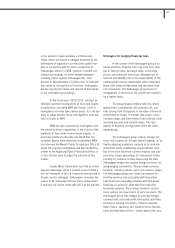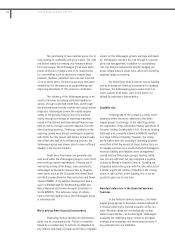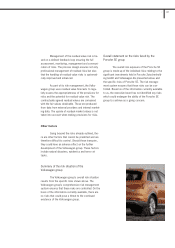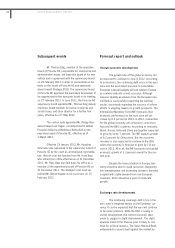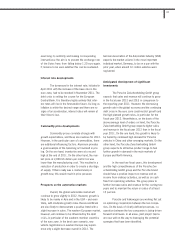Porsche 2011 Annual Report Download - page 121
Download and view the complete annual report
Please find page 121 of the 2011 Porsche annual report below. You can navigate through the pages in the report by either clicking on the pages listed below, or by using the keyword search tool below to find specific information within the annual report.
Production risk
The natural disasters that struck Japan in
March 2011 also had an impact on the automotive
industry. The damage to infrastructure and the large-
scale or complete destruction of production facilities
affected production systems and supply chains
worldwide. The Volkswagen group responded to the
events immediately: an international task force was
set up, comprising employees from all the company’s
divisions and brands. On a daily basis, it coordinated
measures that maintained the group’s global deliver-
ies and thus ensured its production supplies, ena-
bling negative effects on manufacturing operations to
be avoided almost entirely.
In 2011, the Volkswagen group expanded
production at its international locations significantly.
In order to ensure the necessary capacity, suppliers
also increased their deliveries above and beyond
what was originally agreed. Volkswagen expects
demand to remain high in 2012 and possibly cause
fluctuations, particularly in installation rates of fea-
tures and components. Volkswagen has various tools
with which to limit the risk that it will be unable to
meet spikes in demand and to optimally adapt the
programs at its vehicle and component plants to
current market conditions. These include the turnta-
ble concept as well as extensive flexibility in logistics
and within the existing working time models.
Special risks may arise during large projects.
These result in particular from contracting deficien-
cies, miscosting, post-contracting changes in eco-
nomic and technical conditions, and poor perform-
ance on the part of subcontractors. Appropriate
project control throughout all project phases helps to
counter this risk.
Risks arising from changes in demand
Consumer demand is shaped not only by real
factors such as disposable income, but also by psy-
chological factors that are impossible to plan for.
Increased fuel and energy prices could lead
to unexpected buyer reluctance, which could be
further exacerbated by media reports. This is particu-
larly the case in saturated automotive markets such
as western Europe, where demand could drop as a
result of owners then holding on to their vehicles for
longer.
In 2011, the effects of these psychological
factors that cannot be planned for were again exac-
erbated by the impact of the financial and economic
crisis on the global economic trend and the entire
automotive industry. Some automotive markets were
in a downward spiral, which in some cases assumed
dramatic proportions, while others were supported
through government intervention. The Volkswagen
group was able to effectively counter the risk of
buyer reluctance with its attractive range of models
and in-depth customer orientation.
In addition to buyer reluctance as a result of
the crisis, a combination of vehicle taxes based on
CO2 emissions – like those already structured in
some European countries – and high oil and energy
prices is causing a shift in demand toward smaller
segments and engines in individual markets. The
Volkswagen group is working to counter the risk that
such a shift will negatively impact its financial result
by constantly developing new, fuel-efficient vehicles
and alternative fuels on the basis of its fuel and
drivetrain strategy. In the rapidly expanding markets
of Asia and eastern Europe, risks may also arise due
to government intervention in the form of restrictive
lending or tax increases, for example, which could
reduce private consumption.
121
2


